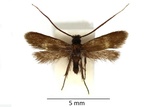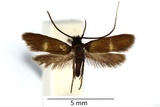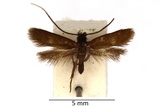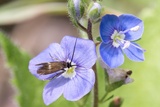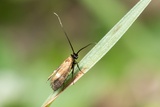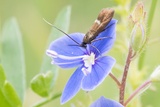Cauchas fibulella ([Denis & Schiffermüller], 1775) Species
Last modified: Dec. 16, 2025, 2:29 p.m.
A rare species throughout Belgium.
Details
- Classification
- Family: Adelidae > Subfamily: Adelinae > Genus: Cauchas > Species: Cauchas fibulella
- Vernacular names
- Dwerglangsprietmot (NL), Little Long-horn (EN)
- First mention in Belgium
- De Fré Ch. 1858. Catalogue des Microlépidoptères de la Belgique. — Annales de la Société entomologique belge 2: 45–162. On page 116 (as Adela (Cauchas) fibulella). view page
- Status
-
Native
Distribution
Imago
Wingspan 9–11 mm. One of the smallest Adelidae. Head black in both sexes. Ground colour is brown, a small whitish dot near the base, and a larger one in the median area. In the males, the basal dot is often absent. In some rare cases, both whitish dots are missing and then the specimens resembleC. rufimitrella.br> Antennae of both sexes are a little longer than the forewing, black at the base and white towards the tip.
Caterpillar
Yellowish white transparent skin through which the inner organs can be seen as light brown structures. Head and prothoracic plate dark brown, mesothoracic plate light brown and metathoracic plate with the same colour as the abdominal segments.
Case
The small case of maximal 5 mm is constructed from soil particles and wittered leaf pieces.
Bionomics
Oviposition in the seed capsules of Veronica. The larva lives at first inside the seed capsules and later on the lower leaves of Veronica chamaedrys.
Hibernation in the larval stage as an almost full-grown larva. The larva feeds further in early spring. Pupation from April in the larval case which is constructed from leaf fragments.
The adults are active in sunshine and resting on the flowers of the hostplant. They almost never leave the immediate growing place of the food plants.
Flight periods
The adults fly in one generation a year from May till July.
Observed on
- Host plant (species):
- Veronica chamaedrys and Veronica officinalis
The larva lives on Veronica chamaedrys from which it first consumes the inner cells of the seed capsule and later on the wittered and dead leaves of the hostplant.
Habitat
Shady places and clearings in forests where Veronica grows; meadows and borders of raised bogs with Veronica chamaedrys.

